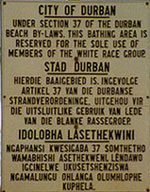This Day in History: March 11, 1978
Additional Date: March 11, 1978
In 1950, the two major pieces of legislation designed to create the new 'apartheid (apart) city' were enacted, namely the Population Registration Act and the Group Areas Act. The first provided for the compulsory classification of the population into racially defined groups and the second was enacted to effect the total urban spatial segregation of the various population groups, as defined by the Population Registration Act. Segregation was further enforced in South African cities and towns through the passing of the Separate Amenities Act in 1953. The Act enforced segregation of all public facilities, including buildings, and transport, in order to limit contact between the different races in South Africa. Later known as "petty apartheid", this Act allowed for municipal grounds to be reserved for a particular race. It created, among other things, separate beaches, buses, hospitals, schools, cinemas, theatres and universities. Signboards such as "whites only" applied to public areas, including park benches. On 11 March 1978, the Apartheid government agreed to eliminate racial segregation in theatres, but not in cinemas. The Act was eventually abolished by President F.W. de Klerk on November 16, 1989, a few months before the unbanning of political parties in 1990 and the beginning of conciliatory negotiations.
